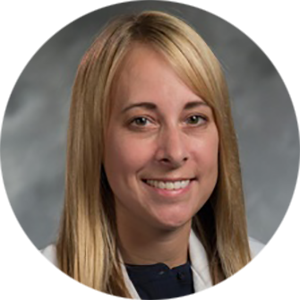
This week’s faculty spotlight shines on Kristy Pahl, MD, assistant professor of pediatrics in the Division of Hematology-Oncology. Pahl explains that she became interested in pursuing a career in medicine at a very young age and never lost that passion. She also talks about her perceptions of the biggest current challenges and opportunities in the field of pediatric hematology-oncology and shares her reflections on her most significant mentors, Dr. Raj Kasthuri and Dr. Julie Blatt. She also offers some insights into her research focused on examining coagulation abnormalities in patients with venous or venolymphatic malformations as well as her work as a member of the Solutions for Patient Safety Hospital-Acquired Venous Thromboembolism (HA-VTE) prevention group at Duke.
How long have you been at Duke? How did you decide to come here?
I have been at Duke for the past three years. I am originally from the Midwest, and wanted to escape the cold and snow. I moved to North Carolina for my Peds Hem/Onc fellowship, and discovered that I love North Carolina and did not want to leave! Luckily as I was finishing fellowship at UNC, Duke had an opening for a pediatric hematologist with an interest in coagulation, so things worked out perfectly. I was excited to come to Duke for the opportunity to build a coagulation program and work with the vascular anomalies team.
What are your current responsibilities in the Department of Pediatrics? What does your typical day look like?
I am the Director of the Pediatric Hemostasis and Thrombosis Program, and I lead our inpatient hematology consult service. The majority of my time is spent taking care of children both in the inpatient and outpatient setting with a variety of bleeding or thrombotic disorders. I also have a special interest in taking care of patients with vascular malformations, and I am a member of the Duke Vascular Anomalies team.
How and when did you initially become interested in medicine? What made you decide to pursue a career in pediatric hematology-oncology in particular?
I have wanted to be a doctor for as long as I can remember; apparently, I came home from kindergarten and announced that I was going to be a doctor and never changed my mind! After completing the hematology/oncology domain during my second year of medical school, I knew I had found my passion.
What do you see as the biggest current challenges and opportunities in the field of pediatric hematology-oncology?
Pediatric hematologists/oncologists are becoming more involved in the management of patients with vascular malformations, and this has been exciting to see. Our understanding of the genetic basis of these malformations and our ability to repurpose targeted therapy originally developed for oncologic indications is growing, expanding our ability to medically manage these malformations. We currently have so little to offer complex patients with extensive vascular malformations, and I look forward to the day (hopefully soon) that this is no longer the case.
Can you tell us about the research you are currently involved in?
Currently I am working on a project examining coagulation abnormalities in patients with venous or venolymphatic malformations. This study is examining the role of platelet factor 4 as a diagnostic marker for localized intravascular coagulation (LIC) in patients with vascular malformations. I am examining how clinical factors such as malformation size, location, and patient age influence response to anti-coagulation management of LIC. I also am the site-PI for a clinical trial investigating the role of a topical PIK3CA inhibitor for the treatment of vascular malformations.
Additionally, I am a member of the Solutions for Patient Safety Hospital-Acquired Venous Thromboembolism (HA-VTE) prevention group here at Duke. This group is working to develop a screening tool for anti-coagulation prophylaxis in hospitalized pediatric patients. I also serve as site-PI for the Children’s Hospital Acquired Thrombosis study, a multi-center national study examining risk factors for HA-VTE in the PICU. The ultimate goal of this project is to develop a risk-based assessment model for anti-coagulation prophylaxis specifically for PICU patients.
What do you enjoy most about your work?
I work with an amazing team of people who help me take care of often very complex patients. For the hematology patients I follow on an extended basis, I enjoy developing long-term relationships and helping children and their families navigate chronic illness. I enjoy the diagnostic and management challenges that exist in hematology, especially in regards to my patients with vascular malformations.
Who was your most significant mentor and what knowledge did you gain through this collaboration?
I have been lucky to have a number of wonderful mentors throughout my medical training. During my pediatric residency at the University of Rochester, I met a number of amazing pediatric hematologists/oncologists who provided mentorship and support as I explored the field. During my fellowship training my primary mentor was Dr. Raj Kasthuri, who is an adult hematologist at UNC, and Dr. Julie Blatt, a pediatric hematologist/oncologist at UNC. Drs. Kasthuri and Blatt introduced me to the field of vascular malformations, taught me how to care for these patients, and introduced me to a network of physicians throughout the country who care for these patients and who are actively involved in research.
What passions or hobbies do you have outside of Duke?
Outside of Duke I spend most of my time chasing around my 2 year old daughter. My husband, daughter and I love to go on hikes, bike rides, and garden. If I have any spare time, I am usually watching HGTV and planning my next home improvement project.